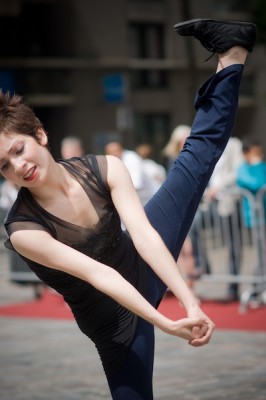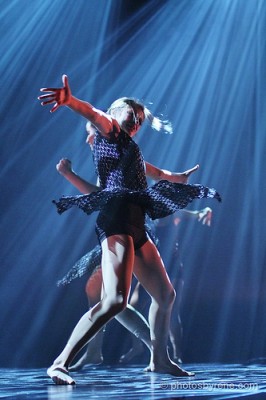What is contemporary dance?
How is it different from modern dance, or jazz dance?

Good questions that get asked a lot! And not just by newcomers to dance.
It seems the entire dance community is trying to sort it all out…
- Four months ago, I got an e-mail from a reader who e-mailed me wondering if I had written anything on the topic. Seems she had been to some workshops and asked around, hoping for some clarification on the term. She came up empty.
- Our new columnist, Heather Vaughan-Southard recently called describing contemporary dance ‘The Next Verbal Challenge‘ on her EducatingDancers blog.
- And that was expounding on a conversation happening on Twitter (in 140 characters) and mentioned by Jordon Cloud on her blog about the differences between contemporary and modern dance.
- And fellow dance writer and Houstonian, Nancy Wozny, penned The Contemporary Conundrum for Dance Spirit Magazine. It’s not a new article but the questions sure are familiar.
The point is, this is an ongoing conversation. I’m sure none of us were the first and we are obviously not the last thinking, processing, and scribbling about it.
EDITOR’S UPDATE: More scribblings
- So you think you can tell me… what contemporary dance is? (Sarah Linstra)
- How do you define Contemporary Dance? (Dance Studio Life)
- What Is “Contemporary” Dance? (Dance Doc’s Think Tank)
- What Is Contemporary, According To Nigel Lythgoe (Wet Paint – SYTYCD)
- ‘Contemporary’ Dance, My Take On It (MaryJane O’Reilly)
- What is the difference between “Modern Dance” and ” Contemporary Dance”?
I’ll add more interesting articles as I find them.
I’ve been sitting on this post really, picking at it until I felt like I’d nailed it. Problem is, it refuses to be nailed. The subject really should be (and probably is) somebody’s Master’s thesis.
BUT it deserves to be talked about among undergrads and younger students as well. Students need to hear the perspectives and some of the history and experiences behind them.
And so I throw my thoughts into the fray. A scholar I am not, but let’s see where they go and what you do with them, shall we?
I’ll start with my Bottom Line first…
(you’ll forgive the language, I hope)
Labels suck but we kind of need them.
Can ‘contemporary’ be taught?
You have probably heard the term Contemporary Dance used as a noun (as in, “I am taking Contemporary Dance lessons,” or “That dance was Contemporary, not Jazz.”).
Maybe I’m just splitting hairs, but I’m not fond of contemporary dance as a term for something learned or taught. And referring to it as a dance form, style, or genre usually raises hairs on the back of my neck, too.
Teachers use strategic techniques and methods to prepare dancers for the work they do in performance. There are dance techniques or methods (Graham, Humphrey, Horton, Limon, Hawkins, Dunham, Cunningham, or Vaganova, Cecchetti, Bournonville, or Giordano, Luigi, Mattox.) that can be taught.
If you are currently taking “Modern Dance”, your training may blend multiple training methods within the same class. Many schools and studios have moved away from teaching these techniques in their purest form.
From where I stand, techniques (long-term training methods) in contemporary dance have not emerged, though I can’t say this won’t or isn’t changing as I write this.
Perhaps a “contemporary dance class” would thoroughly blend modern, jazz, and ballet techniques. But isn’t this triad already covered in most concert and commercial dance training already?
What does ‘contemporary’ look like?
In general, contemporary dancers (dancers of right now) are on a quest which lies at the heart of all evolutionary art-making… the search for something that feels new or now. They…
- are interested in blending or drawing from the ballet, jazz, modern, and other techniques in which they’ve trained
- are athletic and have a strong technical focus which allows them to move between and bend genres with ease
- are willing to borrow or dabble in ideas and approaches to choreography from the past
- often experiment with movement disciplines outside the realms of theatrical or concert dance.
The characteristics of contemporary dance reflect these interests and goals but I can’t identify a ‘look’ to the movement or choreography among those that call themselves contemporary dancers.

Is contemporary commercial or concert?
Some dance, like the choreography on So You Think You Can Dance, appeals very much to our popular culture’s sense of taste. The show’s artists simultaneously appeal to and establish commercial tastes, or aesthetics.
Concert dancers and companies affect, and are affected by contemporary trends as they broaden the definition of dance. Lines are blurry. Concert dance companies are taking notes on marketing their artwork and *gasp!* maybe even welcome commercial appeal. Commercial dancers raise the bar with the level of artistry in their work.
Dancers are staying less within one particular bubble, passing easily across what remains of concert and commercial boundaries. Instructors are teaching a diverse range of dance forms and eclectic methods in universities and sometimes even traditional training environments.
So what is contemporary dance?
There are several uses for the word contemporary but you can boil all of them down to one definition: of the same time.
The word modifies or describes a noun (like dance for example).
Contemporary dance is what it sounds like: dance that belongs to or exists in a time period… right now.
In this way, everything on SYTYCD is contemporary. Concert dance, musical theatre, the avant-garde, even ballet made by contemporary dancers and happening in the vicinity of right now is contemporary dance.
- Right now, in a fast-paced and interconnected world, dance trends seem to form and meld so quickly that it is sometimes hard to pin them down before they take another leap forward. Small movements are happening all the time.
- Right now, unlike some of the dance movements of the past, is one of inclusion, not rejection (unless it is rejection we are rejecting?).
- Right now, dancemakers acknowledge what has come before, sometimes fully embracing it and sometimes just using what they will to build their own unique vision. Perhaps dancers have always done this, but now more than ever, it seems to be an open acknowledgment of relationships.
What’s in a name?
Clearly, ‘modern’ is another confusing term we use to define some dance.
Before there was the term Modern Dance, some dancers of the early 1900s sparked a movement when they chose a new approach to dance that was free, informal, and experimental. They sought to reject or distance themselves from the training, heirarchy, and themes of ballet.
Those who sought to establish a set of techniques that served their individual approach to dance and expression, and develop technical dancers in a track independent of ballet, strengthened the movement.
This expressionistic rebellion against ballet, this movement, moved on. Its dancers (those that affiliated themselves with the modern dance movement) have moved or passed on as well.
So why do we call this movement, or approach, its dancers or techniques, modern? It may have seemed appropriate at the time to call this new work modern (recent or right now). The label stuck.
Yet dance is never stuck, it is ever evolving.
What happened when dance moved on?
Postmodern dance (a term you’ll most often hear slung around on a university campus) was a movement as well.
During the 1960’s and 70’s, a group of people who had trained in and felt bound by the techniques and performance trappings of their “modern” dance predecessors, furthered some artistic ideas that were removed and against the grain of their upbringing.
Their impact was powerful enough to establish a differentiation or mark a shift in the approach to dance-making. Rejecting form and content, postmodern choreographers often stripped dance of emotional expression, technical foundation, and/or theatricality. They not only questioned “what is dance?” but brought forth the idea that “perhaps this is dance,” “…and maybe this,” …or this!”
We’ve moved beyond the postmodern movement and many of its motivations as well. Yet, we continue to blur and blend boundaries during this contemporary time period.
Full circle
So what really bothers me about using contemporary dance as a noun, a form, a look, a SET thing? Pretty soon (it may be too late) the label will stick.
And like “modern” dance before it, dance will move onward into a new right now where we will be stuck with yet more unfortunately named and confusing terminology.
 Linking vs. Labeling
Linking vs. Labeling
Dance is tied to traditions and perspectives of the past and connects to others existing in the present.
The borders between corn fields are nearly indistinguishable when you are among the stalks. They only become clear as you move above and away from them. In a few hundred years we will probably see changes and shifts along the timeline of dance more clearly.
In the Right Now, rather than trying to label or categorize dances or movements as one form or another, you might think of the process as distinguishing or guessing the dance’s lineage and relationship to various techniques or approaches.
This requires looking back through dance history (kind of like we did above) AND looking at a wide sampling of the dance going on right now to fine-tune your “eye” for connections. It leaves a lot of room for interpretation, but the result is generally more accurate than any labeling.
Take some time to explore and experience a variety of dance and dance artists. Do it one piece at a time, but be willing and open to the observation. You’ll be amazed at the bonds, parallels, and inspirations evident in the choreography on TV or on stage.
“There are no new ideas. There are only new ways of making them felt.” ~ Audre Lorde
“It doesn’t matter how new an idea is: what matters is how new it becomes.” ~ Elias Canetti
Nichelle Suzanne is a writer specializing in dance and online content. She is also a dance instructor with over 20 years experience teaching in dance studios, community programs, and colleges. She began Dance Advantage in 2008, equipped with a passion for movement education and an intuitive sense that a blog could bring dancers together. As a Houston-based dance writer, Nichelle covers dance performance for Dance Source Houston, Arts+Culture Texas, and other publications. She is a leader in social media within the dance community and has presented on blogging for dance organizations, including Dance/USA. Nichelle provides web consulting and writing services for dancers, dance schools and studios, and those beyond the dance world. Read Nichelle’s posts.

